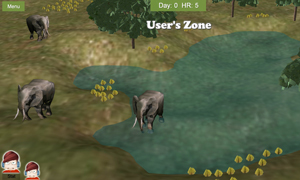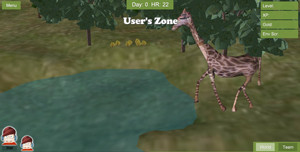SF State students design online game to explore ecosystems
Dec. 22, 2011 -- Ilmi Yoon’s computer science students have one semester to build an entire virtual world from scratch.

An image of gameplay from "Beast Reality," a video game created by SF State computer science students.
Their assignment, as they’ve chosen to accept it, is to create “Beast Reality,” a game inspired in part by the nurturing component of the wildly popular online game Farmville and in part by the space invasions of StarCraft, another popular online strategy game. Inside Beast Reality, players build complex ecosystems and decide to cooperate with — or destroy — the ecosystems created by other players.
It’s a demanding project that gives Yoon’s students practical experience in all of the steps involved in building a game, including concept design; implementing a game client, server and network; database design and development, integrating, testing; marketing; and team collaboration.
Yoon, an associate professor in the SF State Computer Science Department, says Beast Reality can also help ecologists unravel the complex relations within and between ecosystems. At the same time, the players benefit by learning important aspects of ecosystem nurturing and food-web stability while producing significant amounts of scientific data for ecologists that would not be feasible for them to produce themselves.
“Multiplayer Online Game style is a new multi-faceted medium of communication to reach the masses effectively that fosters healthy interaction and team cohesion,” Yoon said. World of Warcraft is a popular game from this category. Beast Reality is partially similar to Farmville, which focuses primarily on team collaboration to build and nurture an ecosystem, and partially similar to StarCraft, where two teams battle for survival.
As Yoon’s students soon find out, development of a multiplayer online game like Beast Reality requires understanding the technical components of computer graphics, 3D modeling, game engine scripting, network, client-server architecture, database, quality assurance and software engineering. At the beginning of the semester, the students are divided into teams to complete the project, much like they would be in a game design company.
Students participate on more than one team and teams present what they learn to the other students, “bringing everyone on the same page,” Yoon said.
There are nine teams: game concept design, game client, game server, database, game content (which includes collecting scientific data and developing communications with population dynamics computational modules used by food web ecologists), art team, test team, game launching team and IT team.
Beast Reality is the second game developed by Yoon’s students. The first semester she taught the class, her students created “deBugger,” a game to teach programming skills to introductory computer science students.
Jason D’Silva, who graduated from SF State this summer with a master’s in computer science, was a member of the deBugger class. He came to school with some industry experience but, “as it is in most companies, I worked on only a part of the software,” he explained. “So I was only aware of ‘my part’ of the work.”
In Yoon’s class, he added, “I was group leader of the client development group. So I had to manage the entire group, delegate work appropriately and manage communications between team members as well as across different teams.”
The class emphasizes collaboration and documentation. During the semester, each student or teams face challenges. “We work hard to resolve these new problems,” Yoon said, because companies need employees with problem solving skills. “New technical tools appear every year, and students jump into using those new tools very quickly,” she explained. “But companies expect software engineers and computer scientists to solve challenges through communications and never-giving-up spirit and be able to communicate their ideas fluently.”

An image of gameplay from "Beast Reality," a video game created by SF State computer science students.
“I love giving students complicated problems that they can solve as a whole class,” Yoon added, noting that this semester’s group of 22 students has grown more confident as the project has progressed.
Students aren’t required to have any particular art or database skills before starting the game project, but Yoon said the class has a way of bringing out hidden talents. “I’m always surprised to find the artists in the class after that first week. They impress me so much.”
After some initial direction from Yoon, the student teams work independently and often meet voluntarily outside of class. When the game is completed, the students may choose to market it online or sell it to a software company. “I’m hoping it will be great preparation for their careers,” Yoon said, “and that they’ll appreciate it when they find a job and start working in a company.”
D’Silva now works at the startup Izelis, Inc., which is developing its first Facebook game. “The best part of working here is that I get to use similar concepts that I used in my game design class as well as the other classes that I had attended at SF State,” he said. “I get exposed to the work industry and I get to use what I learned and see it come to life as a finished product.”
Multiplayer online games evolve depending on the needs or desires of the players, unlike games where all the possibilities are fixed from the start. This makes a game like Beast Reality particularly useful to ecologists, Yoon said, who could use the game to explore the complexity of real-world ecosystem interactions. Some of the data used in Beast Reality comes from the Pacific Ecoinformatics and Computational Ecology Lab or “PEaCE” Lab, based in Berkeley.
Scientists’ own software simulations of ecosystem dynamics “are usually run with certain parameters,” Yoon noted. “But here the players are always tweaking the parameters, which can produce useful data for researchers.”
“Gamification” — where software designers use fun, interactive and encouraging techniques to draw players into solving complex problems — is already impacting the sciences, Yoon said. She pointed to a recent technical paper in the journal Nature Structural & Molecular Biology discussing how an online game called Foldit helped solve the molecular structure of a complicated HIV enzyme.
The success of games from Foldit to Farmville also shows that “popular games do not have to have destructive elements in them,” Yoon said. She’s looking forward to having her students join this thriving group of online games when Beast Reality makes its public debut at the end of the Fall 2011 semester.
Share this story:
